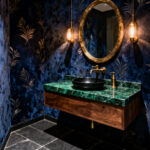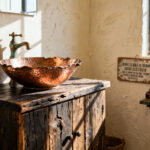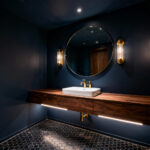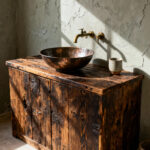Have you ever walked into a living room and instantly felt at home? That cozy, inviting feeling makes you want to sink into the sofa and stay a while. As a home designer based in Boulder, Colorado, I’ve enjoyed creating living spaces that evoke that sensation. And the secret? Embracing a blend of different interior design styles.
The living room is the heart of the home—a space where we gather, relax, and entertain. Whether you’re drawn to the rustic charm of farmhouse style or the free-spirited flair of boho, there’s a way to capture that cozy, comfortable vibe. In fact, according to a survey by the American Society of Interior Designers, 61% of homeowners prefer a mix of styles in their living room rather than a single aesthetic.
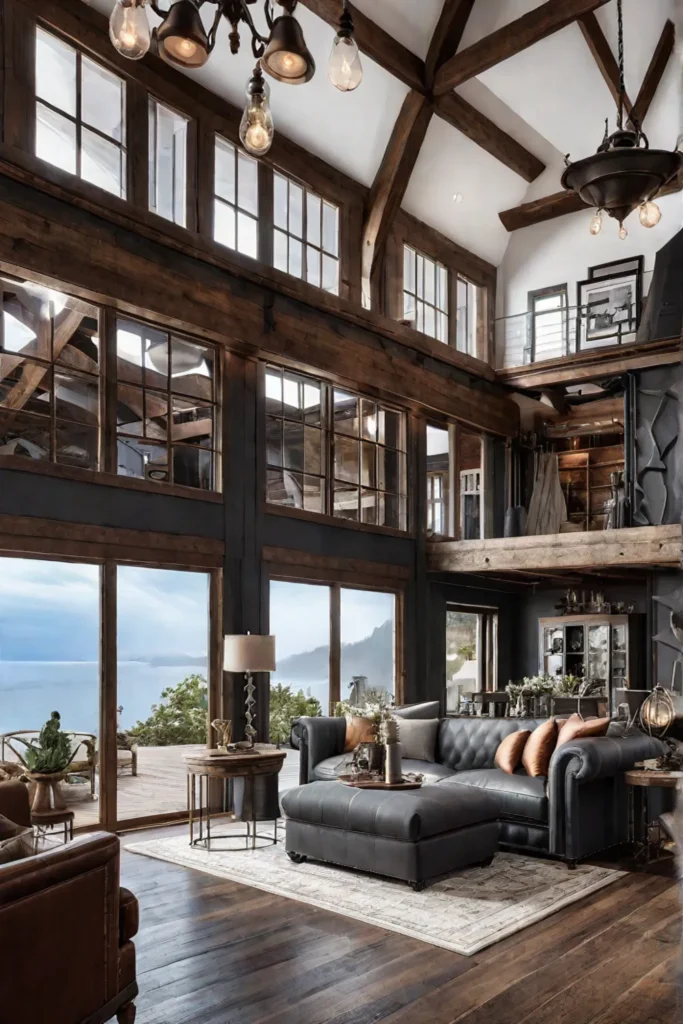
In this article, we’ll explore five distinct interior design styles—farmhouse, boho, Scandinavian, mid-century modern, and industrial—and how you can incorporate elements of each to create a living room that’s uniquely your own. Get ready to be inspired because we’re about to embark on a journey from farmhouse to boho and beyond!
Farmhouse Style
If you love the idea of a living room that feels like a cozy country escape, farmhouse style is right up your alley. This warm, inviting aesthetic draws inspiration from rural, rustic living, and it’s all about embracing natural materials, vintage accents, and a lived-in, comfortable vibe.
One key element of farmhouse style is the use of neutral color palettes, often featuring soft shades of beige, brown, and gray with pops of soft blues, greens, and whites. These calming tones create a serene, welcoming atmosphere, perfect for unwinding after a long day.
Distressed wood furnishings and exposed beams are also hallmarks of the farmhouse look. These natural materials add character and texture to the space, while vintage or antique decor pieces like chandeliers, mirrors, and textiles enhance the sense of history and nostalgia.
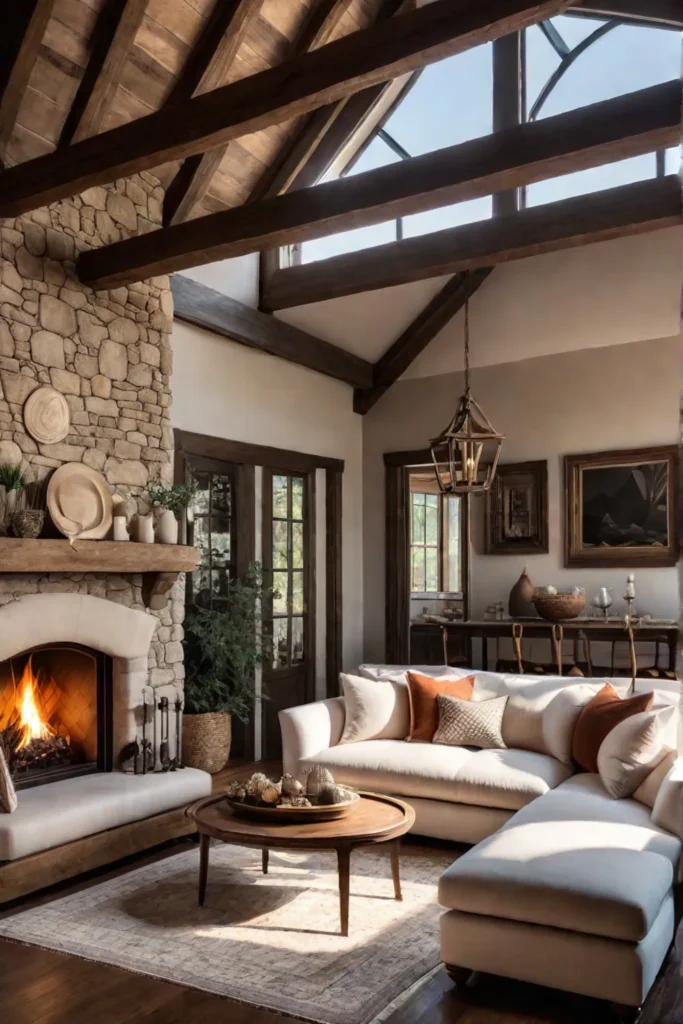
But farmhouse style isn’t just about aesthetics and embracing the great outdoors. Incorporating natural elements like shiplap, stone, and woven accents can help bring the beauty of nature inside, creating a harmonious living space that feels in tune with its surroundings.
As you can see, the farmhouse style is all about comfort, coziness, and a connection to the land. And the best part? It can be easily blended with other design aesthetics, like industrial or boho, to create a truly unique and personalized living room.
Boho Style
If farmhouse style is about rustic charm, then boho style is about free-spirited flair. This eclectic, unconventional aesthetic celebrates individuality, creativity, and a deep appreciation for the natural world.
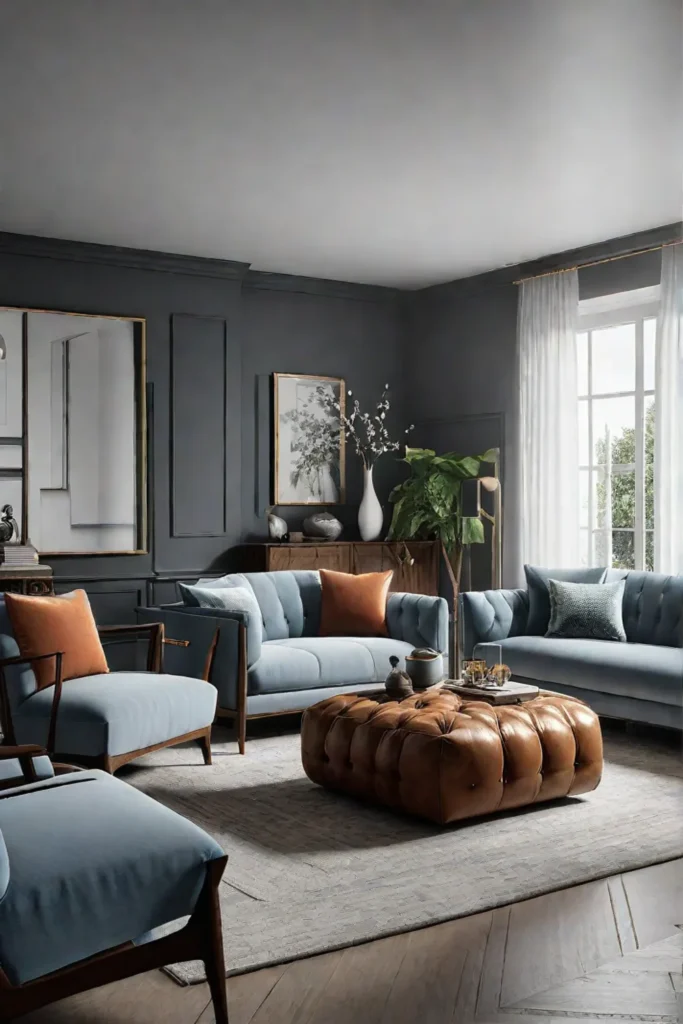
One of the defining features of the boho style is its rich, jewel-toned color palette. Think deep blues, lush greens, and vibrant reds – these bold, vibrant hues create a warm, inviting atmosphere perfect for a cozy living room.
But color is just the beginning. Boho style is about layering textures and patterns, from macrame wall hangings to patterned rugs and tapestries. These elements add depth and visual interest to the space while contributing to that signature boho vibe.
Of course, no boho-inspired living room would be complete without a touch of the great outdoors. Incorporating natural elements like plants, rattan, and woven accents can help bridge the gap between indoor and outdoor spaces, creating a seamless flow and a deeper connection to nature.

And let’s not forget about the mix of vintage and handmade decor pieces essential to the boho look. These one-of-a-kind items add character and personality to the space, reflecting the homeowner’s unique style and creative flair.
Whether you’re drawn to the rich, jewel-toned color palette or the eclectic, layered textures, boho style is all about embracing your inner free spirit and creating a living room that reflects who you are.
Scandinavian Style
If you’re a fan of clean lines, minimalist design, and a serene, calming atmosphere, the Scandinavian style might be what you’re looking for. This design aesthetic, which has its roots in the mid-20th century, is all about functionality, simplicity, and a deep connection to nature.
One of the hallmarks of Scandinavian style is the use of a neutral color palette, often featuring soft shades of white, gray, and beige. These light, airy tones create a sense of openness and tranquility, making the living room feel like a peaceful oasis.
But Scandinavian design is about more than just color—it’s also about furniture. Scandinavian-inspired pieces are known for their clean, streamlined silhouettes and focus on functionality. Think sleek, minimalist sofas and armchairs with simple, elegant coffee and end tables.

Of course, no Scandinavian-inspired living room would be complete without a touch of nature. Incorporating natural materials like wood, wool, and linen can help ground the space and create a sense of warmth and coziness. Don’t forget to bring in some potted plants or natural accents to further enhance that connection to the great outdoors.
Another key principle of Scandinavian design is the concept of “hygge,” a Danish word that roughly translates to “a mood of coziness, comfort, and wellness.” By embracing this philosophy and creating a serene, calming, and relaxing space, you can transform your living room into a true oasis of tranquility.
So, if you’re looking to create a living room that’s both beautiful and functional, with a nod to the natural world, the Scandinavian style might be the perfect fit.
Mid-Century Modern Style
If you’re a fan of sleek, sophisticated design with a retro twist, then mid-century modern style might be right up your alley. This timeless aesthetic, which emerged in the 1950s and 1960s, is all about clean lines, organic forms, and focusing on function.
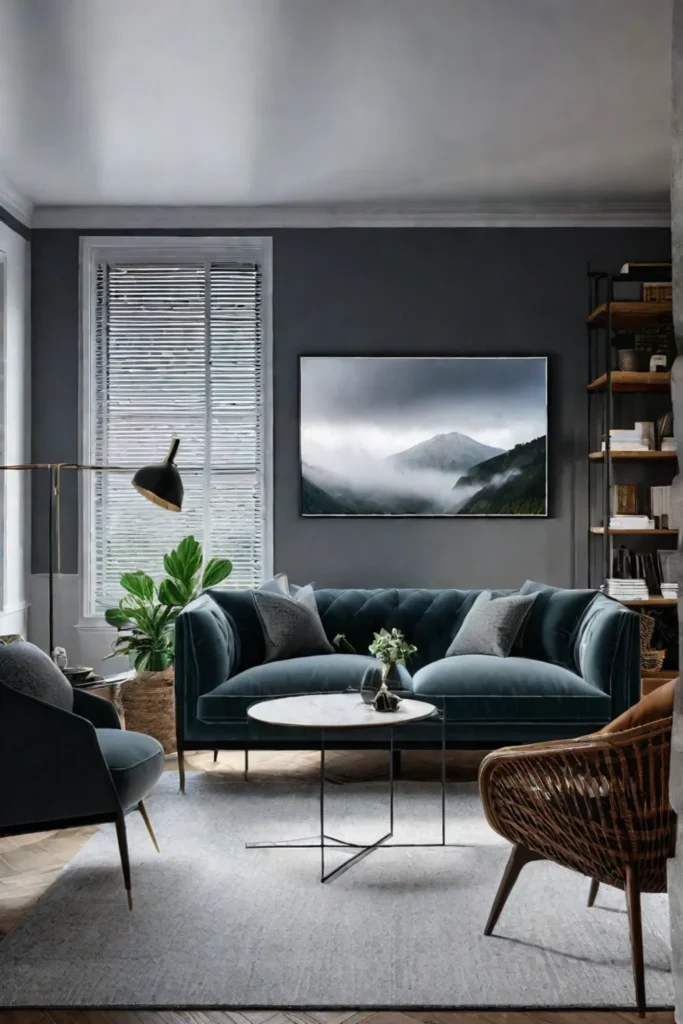
One of the defining features of mid-century modern style is its warm, earthy color palette, often featuring shades of brown, orange, and mustard yellow. These rich, inviting hues create a sense of depth and warmth, while pops of bold, vibrant colors add a touch of visual interest.
However, the true hallmarks of mid-century modern design are the iconic furniture pieces that have stood the test of time. Think Eames chairs, Saarinen coffee tables, and Noguchi lamps—these sleek, sculptural pieces are not only beautiful but also incredibly functional, with a focus on ergonomics and user experience.
The mid-century modern design also strongly emphasizes using natural materials, like teak, walnut, and leather. These organic elements help to ground the space and add warmth and texture, creating a perfect balance between the clean, modern lines and the cozy, inviting feel.
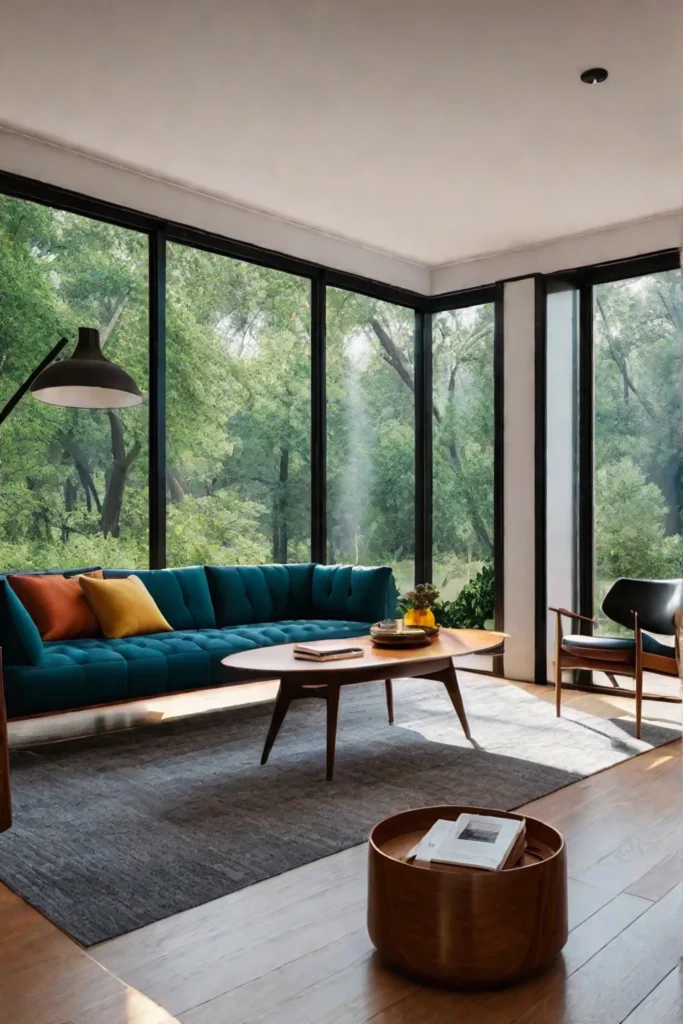
And let’s not forget about the connection to the great outdoors. Mid-century modern style often features open floor plans and large windows, blurring the line between the indoor and outdoor spaces and creating a seamless flow between the two.
Whether you’re drawn to the warm, earthy color palette or the iconic, timeless furniture pieces, mid-century modern style is a timeless choice that can add a touch of sophistication and elegance to any living room.
Industrial Style
If you’re looking to create a living room that’s both gritty and gorgeous, then industrial style might be just the ticket. This urban-inspired aesthetic celebrates the raw, unfinished beauty of materials like metal, concrete, and exposed brick, creating a functional and visually striking space.
One of the defining features of industrial style is its neutral color palette, often featuring shades of black, gray, and metallic accents. These muted tones create a cohesive, sophisticated look perfect for a living room, while pops of bold, contrasting colors can add a touch of visual interest.
But industrial style is about more than just color—it’s also about the materials. Incorporating industrial materials like steel, iron, and concrete can help create a sense of rugged, urban charm, while exposed architectural elements like ductwork, pipes, and brick walls add character and authenticity to the space.

Let’s not forget about the emphasis on open floor plans and repurposed decor pieces. Industrial-inspired living rooms often focus on functionality and minimalism, with a nod to the past through the use of salvaged or reclaimed materials.
Whether you’re drawn to the gritty, edgy vibe of industrial style or want to create a living room that’s visually striking and incredibly functional, this design aesthetic has a lot to offer.
Mixing and Matching Styles
While each of these five interior design styles has its distinct aesthetic, you don’t have to choose just one. Many homeowners mix and match elements from different styles to create a unique and personalized living room space.
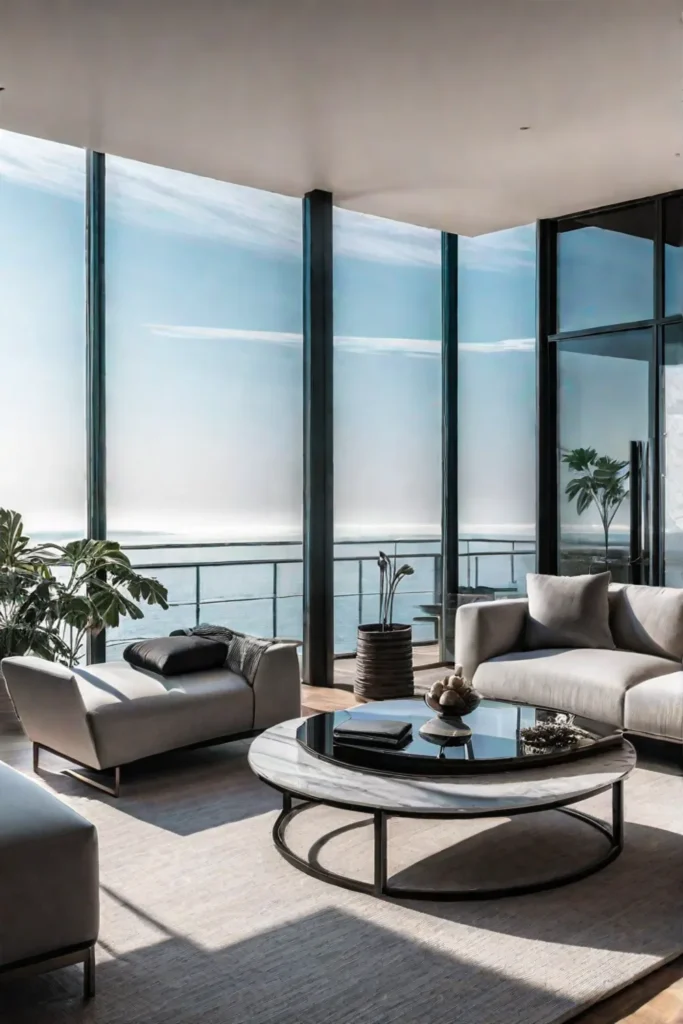
The key to successfully blending multiple design styles is identifying the core design elements from each approach and finding ways to incorporate them. For example, you might start with a farmhouse-inspired sofa and pair it with a boho-inspired rug and mid-century modern coffee table, creating a cohesive yet eclectic look.
Of course, balancing these contrasting styles is crucial. By using color, texture, and materials strategically, you can create a living room that feels harmonious and visually appealing. Maybe you’ll pair industrial-inspired lighting fixtures with soft, boho-inspired textiles or incorporate Scandinavian-inspired minimalism with pops of color and global-inspired decor.
And don’t be afraid to embrace your personal style and individual preferences. After all, the most important thing is creating a living room that reflects who you are and makes you feel truly at home. Whether you’re drawn to the rustic charm of farmhouse style or the free-spirited flair of boho, the key is to have fun and let your creativity shine.

Conclusion
In the end, the living room should reflect your personal style and be a haven of comfort and relaxation. By exploring the diverse range of interior design styles, from farmhouse to boho and beyond, you can create a living room that’s visually stunning, deeply personal, and inviting.
So, what are you waiting for? Start mixing and matching; expect

